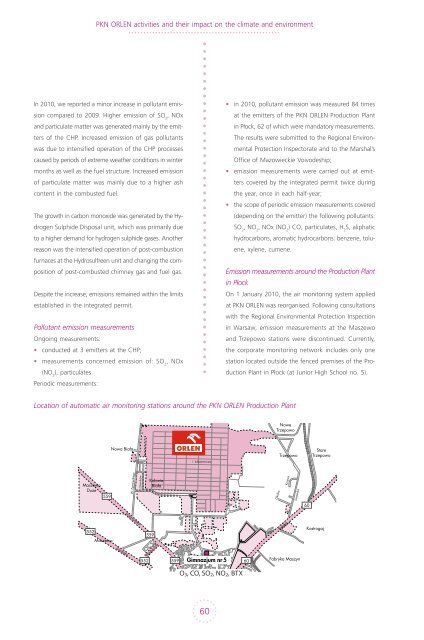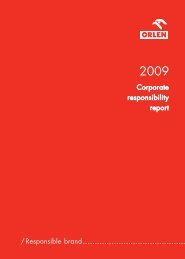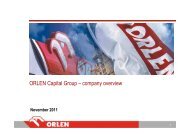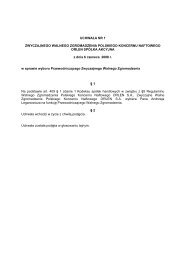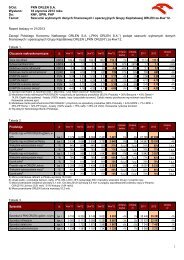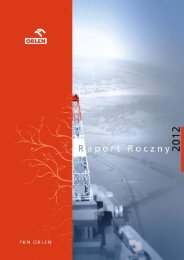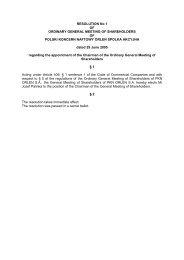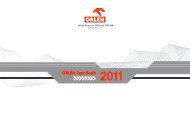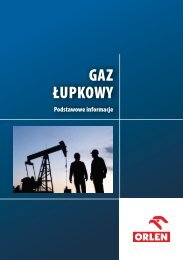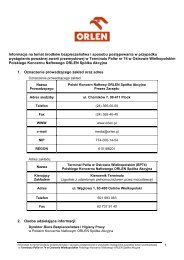safety - PKN Orlen
safety - PKN Orlen
safety - PKN Orlen
Create successful ePaper yourself
Turn your PDF publications into a flip-book with our unique Google optimized e-Paper software.
<strong>PKN</strong> ORLEN activities and their impact on the climate and environment<br />
In 2010, we reported a minor increase in pollutant emission<br />
compared to 2009. Higher emission of SO 2<br />
, NOx<br />
and particulate matter was generated mainly by the emitters<br />
of the CHP. Increased emission of gas pollutants<br />
was due to intensified operation of the CHP processes<br />
caused by periods of extreme weather conditions in winter<br />
months as well as the fuel structure. Increased emission<br />
of particulate matter was mainly due to a higher ash<br />
content in the combusted fuel.<br />
The growth in carbon monoxide was generated by the Hydrogen<br />
Sulphide Disposal unit, which was primarily due<br />
to a higher demand for hydrogen sulphide gases. Another<br />
reason was the intensified operation of post-combustion<br />
furnaces at the Hydrosulfreen unit and changing the composition<br />
of post-combusted chimney gas and fuel gas.<br />
Despite the increase, emissions remained within the limits<br />
established in the integrated permit.<br />
Pollutant emission measurements<br />
Ongoing measurements:<br />
• conducted at 3 emitters at the CHP;<br />
• measurements concerned emission of: SO 2<br />
, NOx<br />
(NO 2<br />
), particulates.<br />
Periodic measurements:<br />
• in 2010, pollutant emission was measured 84 times<br />
at the emitters of the <strong>PKN</strong> ORLEN Production Plant<br />
in Płock, 62 of which were mandatory measurements.<br />
The results were submitted to the Regional Environmental<br />
Protection Inspectorate and to the Marshal’s<br />
Office of Mazowieckie Voivodeship;<br />
• emission measurements were carried out at emitters<br />
covered by the integrated permit twice during<br />
the year, once in each half-year;<br />
• the scope of periodic emission measurements covered<br />
(depending on the emitter) the following pollutants:<br />
SO 2<br />
, NO 2<br />
, NOx (NO 2<br />
) CO, particulates, H 2<br />
S, aliphatic<br />
hydrocarbons, aromatic hydrocarbons: benzene, toluene,<br />
xylene, cumene.<br />
Emission measurements around the Production Plant<br />
in Płock<br />
On 1 January 2010, the air monitoring system applied<br />
at <strong>PKN</strong> ORLEN was reorganised. Following consultations<br />
with the Regional Environmental Protection Inspection<br />
in Warsaw, emission measurements at the Maszewo<br />
and Trzepowo stations were discontinued. Currently,<br />
the corporate monitoring network includes only one<br />
station located outside the fenced premises of the Production<br />
Plant in Płock (at Junior High School no. 5).<br />
Location of automatic air monitoring stations around the <strong>PKN</strong> ORLEN Production Plant<br />
Nowe<br />
Trzepowo<br />
Nowa Biała<br />
Trzepowo<br />
Stare<br />
Trzepowo<br />
I Łukasiewicza<br />
Maszewo<br />
Duże<br />
559<br />
W. Zgienieckiego<br />
Chemików<br />
Kolonia<br />
Biała<br />
Okólna<br />
Krzywa<br />
Sierpecka<br />
Długa<br />
60<br />
552<br />
Maszewo<br />
Szpitalna<br />
Dobrzyńska<br />
552<br />
559<br />
Medyczna<br />
559<br />
Gimnazjum nr 5<br />
60<br />
Bielska<br />
Fabryka Maszyn<br />
Kostrogaj<br />
O 3, CO, SO 2, NO 2, BTX<br />
60


